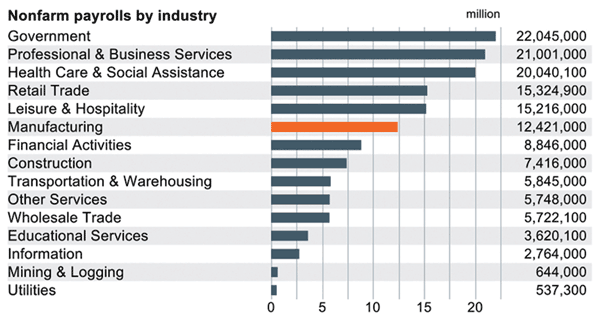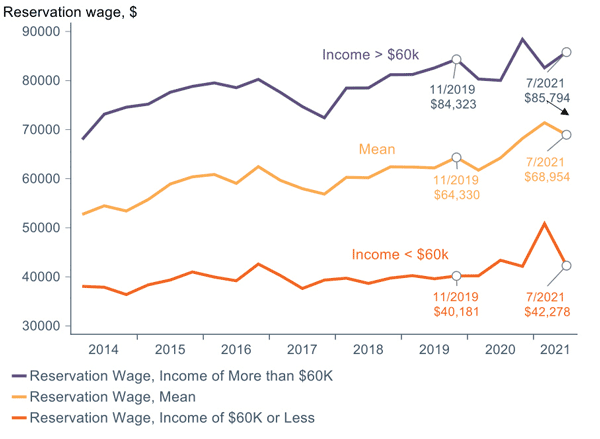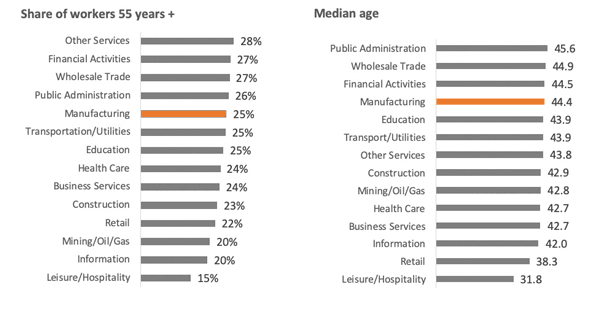LABOR MARKET – A MACRO PROFILE
WILMINGTON TRUST | RHEA THOMAS
LABOR MARKET CHALLENGES IN THE POST-PANDEMIC ECONOMY
The pandemic recession is currently going down in the books as the shortest in U.S. history. But that likely won’t stop it from leaving some scars, as this recession has also been one of the deepest in U.S. history. Nowhere is this more evident than in the labor market, where there are 5.3 million fewer jobs as of August 2021 relative to pre-crisis (-3.5%), despite the economy having recovered to just 1% pre-pandemic levels of output at the end of 2Q 2021. However, one of the surprising aspects of this recession is that in the wake of the pandemic, demand for labor is not the only factor impacting the trajectory of the recovery. Instead, labor supply has also been a key issue for firms, and shortages have been holding back production, particularly in the manufacturing industry.

In our view, some of the constraints holding back labor supply should ease over time as virus and caregiving concerns are mitigated and expanded unemployment insurance benefits expire. But other factors, such as aging and accelerated retirements, are likely to be more persistent drags on labor supply that firms will need to adapt to in the future.
THIS TIME IS DIFFERENT FOR MANUFACTURING
Manufacturing is one of the sectors of the U.S. economy that has turned traditional recession dynamics upside down. The manufacturing industry typically tends to suffer more acutely than the overall economy during recessions, as consumers cut spending on big-ticket items, particularly durable goods. The pandemic, however, induced the opposite reaction.
Consumers rushed out to purchase goods of all kinds—everything from appliances to exercise equipment to electronics—that allowed consumers to cook, exercise, work, and entertain themselves as they hunkered down at home due to virus concerns and restrictions. As a result, spending on goods overall is up 20% relative to pre-pandemic levels, in turn pushing up demand for workers at manufacturing firms that make these goods.
Job openings soared by 121% relative to pre-pandemic levels as of July 2021. Yet, employment in the industry is still down 3% as of August 2021. It is notable that, despite these losses, the industry retained its position as the economy’s sixth-largest employer by industry (Figure 1) and has bucked the typical recession trend, with employment in the industry fairing slightly better than the 3.5% overall loss in jobs across the economy.
SOME LABOR SUPPLY CONSTRAINTS LIKELY TO EASE IN COMING MONTHS
Surveys of manufacturing firms highlight that a low supply of workers, rather than low demand for labor, is the key culprit holding back job growth, as well as production. Some of these labor supply issues are likely temporary and should ease over time as vaccinations and boosters continue to be distributed, as virus trends improve, and children return to in-person schooling. This, in turn, should support the return to the labor force of those workers who may have left because of concerns about the virus or due to child and other caregiving issues. The expiry of expanded unemployment insurance benefits across the remaining 25 states that had not already curtailed benefits as of September 6 and the fading impact of economic impact payments may also prompt some workers to return to work as savings cushions start to dwindle.

Recent data hint at some progress toward workers coming back into the labor force. The Federal Reserve Bank of New York’s latest labor market survey noted that the share of individuals who reported searching for a job in the past four weeks increased to 24.0% in July 2021, up from 19.6% in March 2021. In addition, the survey reported a slight decline in the average reservation wage (lowest wage respondents would be willing to accept to take on a new job) as of July 2021 relative to March 2021 (Figure 2), driven by those with incomes of less than $60,000 (though the average reservation wage still remains elevated relative to pre-pandemic).
This suggests that workers may be more willing to re-enter the labor force relative to March, when the third round of fiscal stimulus checks was sent out, and unemployment insurance benefits were extended prior to the widespread distribution of the vaccine. Analysis from the Indeed Hiring Lab found similar results, with a notable increase in survey respondents actively searching for work as of July (to 31.6%, up from 24.4% in June), and with COVID fears receding sharply as a reason cited for non-urgent job searches. The quits rate of workers in the manufacturing industry (the share of workers voluntarily quitting jobs as a share of total employment) also ticked down slightly in July 2021, after hitting a record high in June. The rise of the Delta variant may stall these trends in the near term, but as virus trends settle, some of these constraints should continue to ease.
OTHER LABOR SUPPLY CONSTRAINTS MAY BE MORE PERSISTENT
Other challenges, such as a drag on the labor force coming from accelerated pandemic-induced retirements, and aging workers more generally, may have longer-lasting impacts on firms’ abilities to rebuild their workforces even after temporary pandemic related effects fade. The Federal Reserve in its July 2021 Monetary Policy Report estimated that even without the pandemic, the aging of baby boomers would have contributed a 0.3 percentage point increase in the share of the population that is retired. However, their analysis found that in the wake of the pandemic, the share of the population that was not in the labor force and retired jumped by a significantly higher 1%, accounting for over half of the decrease in the labor force participation rate from February to May 2021.

The Federal Reserve Bank of New York survey noted earlier also reported that the average expected likelihood of working beyond age 62 moved from 51.9% down to 50.1%, between July 2020 and July 2021, the lowest since March 2014 (the start of the series). The trend toward accelerated retirement may have been spurred on by the increased vulnerability of older workers to the virus and more comfortable household balance sheets of retirees with exposure to housing and equity markets, both of which remained more buoyant during this recession relative to the Great Recession. These factors suggest that accelerated retirement may be a more permanent damper on the labor force and a challenge firms will have to contend with in finding the labor they need to for future growth.
This may pose challenges for the manufacturing industry in particular, given that it had already been struggling with shortages of labor even before the pandemic due to the aging and retirement of its baby boomer workforce. According to the Bureau of Labor Statistics, roughly 25% of workers in the industry were above the age of 55 (compared to 24% for the overall economy) as of 2020, and the median age of workers in the industry is 44.6 (compared to 42.5 for the overall economy). This puts the industry roughly in the top percentile of industries with aging workers.
ADAPTING TO THE NEW NORMAL
While the near-term outlook suggests firms will continue to have strong demand for workers given backlogs of orders that still need to be worked through as a result of lingering supply chain disruptions, the longer-term outlook also suggests demand for manufacturing workers will remain solid in a number of areas.
A trend toward increased investment in technology could be a silver lining of the pandemic.
The Bureau of Labor Statistics projections of the pandemic’s net impact on manufacturing employment through 2029 is positive relative to its baseline pre-pandemic estimates in its moderate impact scenario (+0.6% from 2019 to 2029), though the projections turn slightly negative in its strong impact scenario (-0.1%) due to more pronounced downside impacts on manufacturing in the transportation industry (such as aircraft, ships, and boats). However, both scenarios are expected to boost manufacturing firms’ employment needs in areas like manufacturing of computer-related equipment (as a result of increased remote work), as well as pharmaceuticals and medicines (due to the need for future vaccines), by roughly 19%.
How might manufacturing firms respond to more persistent dynamics of increased demand for workers and a shrinking labor force due to aging? In the near term, firms may raise wages to attract and retain workers. Firms may increasingly turn to technology to work around labor shortages.
A June 2021 Federal Reserve Bank of Kansas City manufacturing survey found that over 40% of firms had already invested, or planned to invest, in labor-saving automation strategies at a faster pace than in the past in order to address labor shortages. A trend toward increased investment in technology could be a silver lining of the pandemic, as it bodes well for the future of the industry in terms of improving productivity. These are themes we will be exploring more broadly in our upcoming Capital Markets Forecast to be released later this year on our website, WilmingtonTrust.com, where you can find also find additional research insights.
DISCLOSURE
Wilmington Trust is a registered service mark used in connection with various fiduciary and non-fiduciary services offered by certain subsidiaries of M&T Bank Corporation. This article is for informational purposes and is not intended as an offer or solicitation for the sale of any financial product or service.
1 Federal Reserve Bank of New York, SCE Labor Market Survey, July 2021
2 Indeed Hiring Lab, Job Search Survey, July 2021
3 Federal Reserve, Monetary Policy Report, July 2021
4 Bureau of Labor Statistics, Current Population Survey, 2020
5 Bureau of Labor Statistics, Employment projections in a pandemic environment, February 2021
6 Federal Reserve Bank of Kansas City, Manufacturing Survey, June 2021

Rhea Thomas is a Senior Economist with Wilmington Trust Investment Advisors (WTIA). She holds a BA in Economics and International Studies from Yale University.



